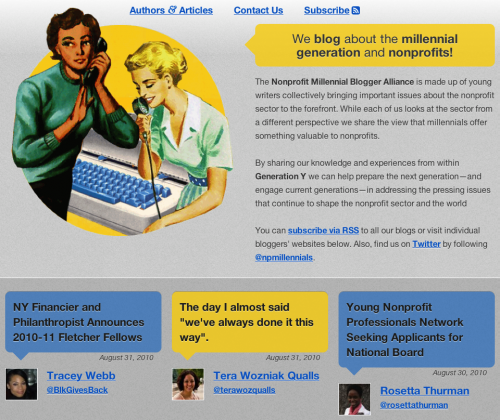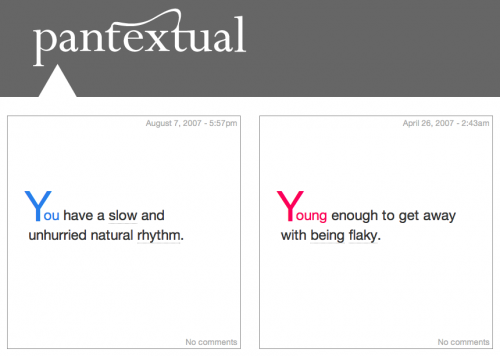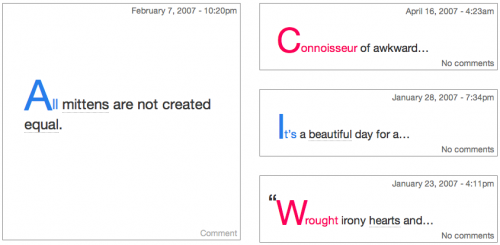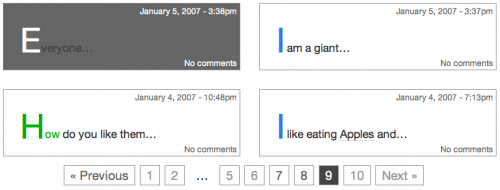My account of meaning is grounded in what real people do when they speak and write. When people speak or write successfully with each other it looks as though there is a transfer of meaning: the speaker puts the meaning into the words and the listener takes it out at the other end. If you look at it from the larger perspective this account is fair: the listener ends up knowing what the speaker wanted him to know and ends up knowing something he never knew before, and so it must be that the words put this knowledge into his head. But it is important also to take a closer perspective and realize that, strictly speaking, words cannot contain meaning. Only people have meaning. Words can only have meaning attributed to them by people. The listener can never get any meaning out of a word that he didn’t put in. Language can only consist of a set of directions for building meanings out of one’s own head. Though the listener’s knowledge seems new, it is also not new: the meaning may be thought of as structures he never had in his head before, but he had to build these new structures out of ingredients he already had. The speaker’s words were aset of directions for assembling this already-present material.
To change the metaphor. Meaning is like movies inside the head. I’ve got movies in my head. I want to put them inside yours. Only I can’t do that because our heads are opaque. All I can do is try to be clever about sending you a sound track and hope I’ve done it in such a way as to make you construct the right movies in your head. What’s worse, of course, is that since neither of us can see the movies in each other’s head, we are apt to be mistaken about how well we are doing in trying to make the other person show himself the movie we have in mind.
We can let ourselves talk about words “having meaning” and even “carrying meaning from one head to another” as long as we now realize these phrases denote something complex: the words don’t transport the contents of my head into yours, they give you a set of directions for building your own meaning. If we are both good at writing directions and following directions for building meaning, we end up with similar things in our heads—that is, we communicate. Otherwise, we experience each other’s words as “not having any meaning in them,” or “having the wrong meaning in them.”
The question is then how these meaning-building rules operate in ordinary language. Meaning in ordinary language—English, for example—is midway on a continuum between meaning in dreams and meaning in mathematics. Dreams may be hard to interpret, but the nature of the meaning situation is very simple because there is no audience. Dreams are all “speaking” and no “listening”: dreams are for the sake of dreaming, not for the sake of interpreting. Therefore, though dreams or dream-images have particular, definite meanings, they can mean anything. They have whatever meaning the dreamer of that particular dream built into them. The rules for dreaming are as follows: let anything mean anything. (We could be fancy and say that the meaning-building rules for dreams are the rules of “resemblance” and “association.” But everything resembles everything else to some extent, and anything is liable to be associated somehow with anything else. Thus anything can mean anything.) If we dream of a gun or a steeple, we may be talking about a penis, but then again we may not. And we may dream about a penis with any image at all. In dreaming you can never make a mistake.
At the other extreme is a language like mathematics. Here people have gone to the trouble to nail down the rules for building meaning into symbols. Something may mean only what these publicly acknowledged rules allow it to mean. In mathematics there are mistakes, and any argument about what something means or whether there is a mistake can be settled without doubt or ambiguity. (Perhaps there are exceptions in some advanced mathematical research.)
Meaning in ordinary language is in the middle. It is pushed and pulled simultaneously by forces that try to make it fluid and dreamlike but also fixed like mathematics.
The individual user of ordinary language is like the dreamer. He is apt to build in any old meaning to any old word. Everybody has just as many connotations and associations to a word as he does to an image. Thus, as far as the individual is concerned, a word is liable—and often tends—to mean absolutely anything.
To illustrate this dream-like fluidity of ordinary language, notice that words do in fact end up meaning anything as they move through time and across mountain ranges. “Down” used to mean “hill” (“dune”), but because people said “down hill” a lot (“off- dune”), and because they were lazy (“adown”), finally hill means down. Philology, it has been said, is a study in which consonants count for very little and vowels for nothing at all. A word may change its meaning to absolutely anything.
But the mathematics-like force for order is just as strong. That is, though words in ordinary language can mean anything, they only do mean what the speech community lets them mean at that moment. But unlike the case of mathematics, these agreements are not explicitly set down and agreed to. That is, our rules for building meaning into words are unspoken and are learned by doing, by listening to others, and even by listening to ourselves. It’s like one of those party games where people get you to start playing before you know the rules of the game and indeed part of the fun is learning gradually to understand the rules after you find yourself following them. When you pick up the rules you can play—you can send and receive messages with others who know the rules. These rules for building meaning may be thought to be written down in dictionaries. But dictionaries are only records of yesterday’s rules, and today’s may be somewhat different. And dictionaries don’t tell all the meanings that speakers send to each other in words.
The dynamism between the dream characteristics and the math characteristics in ordinary language is important: there is a constant tug of war. The individual is tending to allow words to mean anything—just as he allows dream images to mean whatever he builds in. Not because he is naughty but simply because he is a meaning-building creature and cannot refrain from constantly building new meanings into everything he encounters.
But the speech community is constantly curbing this looseness. When an individual speaker means things by a set of words which the community of listeners does not “hear,” he tends to give in to the community and stop meaning those things by those words: that is, when they don’t build in at their end what he builds in at his, he either stops building it in or else remains unconscious of meanings of the words. Similarly, when an individual listener hears things in a set of words which the community of speakers do not mean, he also tends to give in to the community and stop hearing those meanings or stop being aware of having those meanings for those words. (The exceptions to this process illustrate it well. When there are listeners who are especially eager to know what is on someone’s mind—someone like a specially loved child or a poet such as Blake—they will learn to interpret his words even if he talks like a dreamer. If there’s enough utterance and enough care, the code can always be cracked.)
The history of meaning in a language is the history of this power struggle between dream characteristics and math characteristics. Rules for meaning-building change when some speaker is somehow powerful and makes people “hear” in an utterance what they never used to hear in it. And even a listener can be powerful in this subtle way (be an unmoved mover) and make people “mean” in an utterance what they had not meant before. When, on the other hand, the community holds its own, meanings don’t change. Humpty Dumpty put his finger on it:
“But ‘glory’ doesn’t mean ‘a nice knockdown argument,’ “Alice objected.
“When I use a word,” Humpty Dumpty said in a rather scornful tone, “it means just what I choose it to mean—neither more nor less.”
“The question is,” said Alice, “whether you can make words mean so many different things.”
“The question is,” said Humpty Dumpty, “who is to be master—that’s all.”
—Through the Looking Glass by Lewis Carroll
The picture is oversimplified, however, if we talk of only one speech community. For actually there are many overlapping speech communities for each individual—building up to the largest one: all speakers of, say, English. Smaller subcommunities are in the middle in this power struggle. On the one hand, they exert stabilizing force upon the individual’s dreamlike fluid tendency of meaning. But on the other hand, they are not as strongly stabilizing as the larger speech community is—that is, I can change the meaning-building rules of my friends sooner than I can do it to a larger community. And so, in fact, the smaller communities turn out to act as forces for fluidity upon larger communities.
This model implies that meaning in ordinary language consists of delicate, flexible transactions among people in overlapping speech communities—peculiar transactions governed by unspoken agreements to abide by unspecified, constantly changing rules as to what meanings to build into what words and phrases. All the parties merely keep on making these transactions and assuming that all the other parties abide by the same rules and agreements. Thus, though words are capable of extreme precision among good players, they nevertheless float and drift all the time.
Elbow does a better job than anyone in characterizing non-converging processes: change just is. And this is just about the meaning of words; add on to that form, structure, medium, authority and all the other trappings of rhetoric that are themselves constantly reconstructed.
But that is why I’m a language nerd: it’s enjoyable to float on your back in the warm ocean with the sun on your face and feel the lapping of a million tiny waves pushing you about (and imagining the millions of tiny waves pushing them about and so forth). As long as you can balance those thoughts with the vigilance necessary to keep from drifting into the surf zone or floating out to sea, searching for a stationary spot on the beach can’t compare.




